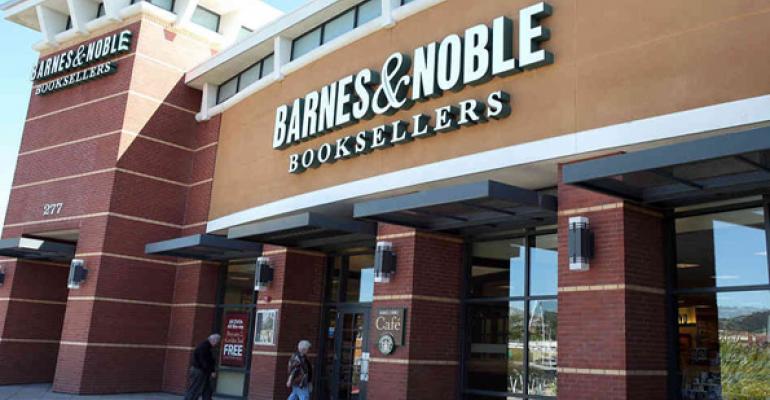(Bloomberg Opinion)—Barnes & Noble Inc. had been buyout bait for so long it should not have been a surprise when the company announced on Friday that Elliott Management Corp. had agreed to buy the big-box book giant for $683 million, including debt. The bookseller had said in October that it was exploring strategic alternatives. Even before that, smart observers such as my colleague Tara Lachapelle had noted it would be a tempting takeout target.
Still, when the moment came, it seemed to be, if not exactly a shock, then certainly an important turning point. Without a doubt it was a humbling moment for a company that has been humbled again and again by retail’s massive transformation. Of course, Barnes & Noble was among the earliest companies to feel the punishing competitive pressure of Amazon.com Inc., with Jeff Bezos’s ruthless convenience machine putting books on shoppers’ doorsteps quickly and reliably. Bezos dealt Barnes & Noble another blow when his Kindle device ushered in the e-books era, threatening to exile the bookseller to oblivion the same way Apple’s iTunes doomed Tower Records and Sam Goody.
Given that history, perhaps it is inevitable that Barnes & Noble is a smaller, less influential retailing force now than it was at the height of its powers. But it was not preordained that Barnes & Noble has become as irrelevant as it has.
As one piece of evidence, look at the extraordinary resurrection of Best Buy Co., the electronics chain that also experienced early encroachment from Amazon. Less than a decade ago, many industry watchers were convinced it was destined to crumble like rival Circuit City did. But CEO Hubert Joly gave people a reason to choose Best Buy — he made prices more competitive, drastically improved customer service and shored up its e-commerce offering. He didn’t let the company wallow in the past, ditching its 250 small-format Best Buy Mobile stores, which no longer made sense as the smartphone market matured.
Barnes & Noble couldn’t have followed Best Buy’s playbook exactly; selling books is simply a different business from selling big-ticket items like 4K TVs. But Best Buy’s example shows it is possible for specialist retailers to remain differentiated and exciting in 2019.
Barnes & Noble even had a solid foundation to build on: It was an experiential retailer long before that term became an overused industry buzzword. Its cavernous spaces with plenty of seating let customers thumb through lots of books before settling on a purchase; its Starbucks cafes gave them permission to linger even longer.
Apple, often lauded as a retail visionary, started referring to its stores as “town squares” in 2017, a nod to the idea that it would be advantageous for them to be community gathering places. Barnes & Noble had understood the power of retail-store-as-hangout-spot at least two decades ago. And then it squandered it by not continuing to evolve how the concept was executed and by failing to marry it with a more compelling online shopping experience and e-reader.
Barnes & Noble’s new CEO, James Daunt, has some obvious opportunities to steady the chain, starting with slimming down. The company still has more than 600 physical stores. That number could soon prove unsustainable even for, say, Macy’s Inc., and the clothing and home goods businesses have not even shifted online as much as the book business has.
Daunt should also further reshape how Barnes & Noble’s allocates space in its stores. I was shocked on a recent visit to a Barnes & Noble store by how much square footage was still devoted to physical copies of movies and music. The company has experimented with remodels to condense those areas and use the space for toys and games. That seems like something worth rolling out chainwide, especially given the disappearance of Toys “R” Us.
Maybe some fresh marketing, too, could drive traffic to Barnes & Noble. Millennial parents are often worried about overdoing screen time for their kids. Why not court them with ads that will make them feel like Parent of the Year for taking their children to pick out an old-fashioned book?
Remember, even Amazon, Barnes & Noble’s mortal enemy, clearly believes in the enduring potential of the physical bookstore. It has opened several of them in recent years, a somewhat ironic bit of validation for Barnes & Noble’s legacy business.
Going private has been anything but a guarantee of salvation in retail. In fact, in several cases, it has been a prelude to grave trouble. Toys “R” Us, most notably, was forced to liquidate after it was crushed by its debt load. Private-equity owned Payless Shoe Source is now shuttering its U.S. stores after filing for bankruptcy; private-equity-backed Wet Seal and The Limited have vanished from the mall.
Barnes & Noble will probably never be the cultural and commercial force it once was, even if it doesn’t end up quite those dire straits. It has missed too many opportunities by now. But it still has a chance to write a next chapter that doesn’t include its demise.
Sarah Halzack is a Bloomberg Opinion columnist covering the consumer and retail industries. She was previously a national retail reporter for the Washington Post.
To contact the author of this story: Sarah Halzack at [email protected]
For more columns from Bloomberg View, visit
COPYRIGHT
© 2019 Bloomberg L.P

